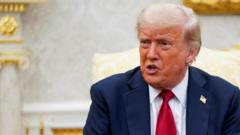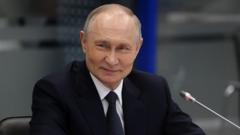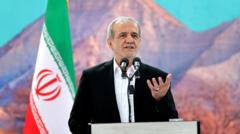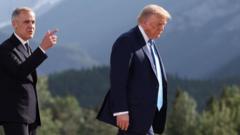President Trump envisions the 'Golden Dome', a next-gen missile defense system, to counter advanced threats such as hypersonic weapons and space-based strikes, despite experts warning of high costs and complex logistics.
Trump's Vision for the 'Golden Dome': A Revolutionary Defense System
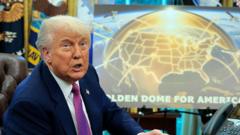
Trump's Vision for the 'Golden Dome': A Revolutionary Defense System
Amid rising global threats, Donald Trump proposes an ambitious missile defense project, the 'Golden Dome', aiming to secure the U.S. from evolving missile technologies.
The United States is facing an escalating array of threats from advanced nuclear capabilities and missile technology, prompting President Donald Trump to propose a groundbreaking missile defense initiative dubbed the 'Golden Dome.' This project aims to modernize America’s defense against a range of perilous missiles, including hypersonic ones that can travel at supersonic speeds and the potential for weapons launched from space.
Recent assessments have raised alarms about the inadequacy of current defense systems, especially given the sophistication of adversaries like Russia and China. Experts have warned that a single nuclear explosion occurring hundreds of miles above the U.S. could unleash a catastrophic electromagnetic pulse (EMP), crippling everything from electrical grids to daily communication systems. Defense analyst William Fortschen remarked, “We wouldn’t be going back 100 years; we’d lose everything.”
In response to these threats, Trump articulated his vision for a next-generation missile shield during a joint address to Congress. Initially dubbed the "Iron Dome for America," the Golden Dome is designed to adopt a multi-layered approach to missile defense that includes advanced detection capabilities and interceptors capable of addressing threats from various platforms—including air, sea, and space.
Current U.S. missile defense infrastructures are primarily designed for traditional intercontinental ballistic missiles (ICBMs), with just 44 ground-based interceptors stationed at bases in California and Alaska. But as nations like China and Russia invest in a broader arsenal that includes hypersonic strike systems and orbital bombardment capabilities, experts have indicated that the need for a comprehensive defense overhaul is critical.
Defense Secretary Pete Hegseth emphasized the urgent requirement to adapt the protocol amid a rapidly evolving threat landscape. However, many analysts point out that while forging ahead with the Golden Dome is essential, the financial and logistical complexities are significant hurdles that could thwart its realization. While Trump estimates the cost at approximately $175 billion, including an initial funding allocation of $25 billion, the Congressional Budget Office estimates that developing the necessary space-based defense mechanisms could soar to as high as $542 billion over two decades.
A major hurdle will be the integration of multiple systems into a cohesive structure capable of addressing diverse attack scenarios. As defense expert Dr. Stacie Pettyjohn warned, the likelihood of failures and the necessity for continuous adjustments make expedited development an ambitious, if not unrealistic, objective.
There’s also growing concern that the establishment of the Golden Dome could incite a new arms race, with adversaries potentially escalating their offensive capabilities in response. China’s foreign ministry has already articulated concerns regarding the implications of this plan on global security dynamics.
Despite these challenges, Trump’s administration and several defense analysts argue that enhancing missile defense capabilities is paramount to deterrence, thus lowering the likelihood of attacks on U.S. soil. They defend that even a partially operational Golden Dome could significantly improve national security and deter prospective threats.
As the world watches closely, the success of the Golden Dome initiative could redefine America’s defensive strategies, assuming it can overcome the multifaceted challenges involved in its development. Fortschen asserts that establishing such a system is essential for the U.S., concluding, “We need that type of system. The Golden Dome is the answer.”








